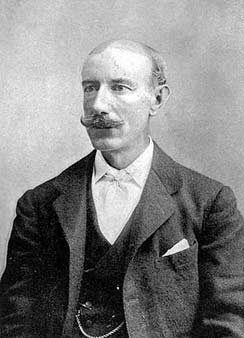Lord Dunraven was an Oxford graduate, cavalry officer, war correspondent, adventurer, big game hunter, politician, racehorse owner and yachtsman. He was also a great lover of the United States and her people, investing in land in Colorado and hunting elk with Buffalo Bill Cody in Nebraska.
A fully qualified yacht captain and helmsman in his own right, he did much to encourage yacht racing and the advance of yacht design. He was also a prolific yacht owner with myriad small racing yachts, Big Class racers, cruisers, and power yachts.
In 1893, Lord Dunraven challenged the Cup’s holder, the New York Yacht Club. During the negotiations over the conditions of the match, Dunraven achieved the concession to drop the Inside Course (a notorious course, riddled with shoals and strong currents, that favored the defender) from the menu of courses used up to that time for the Cup races. From that point on, only the Ocean Course, free from headlands, and largely free of shoals, was used for the races, benefitting all future challengers.
For the match, Dunraven hired the brilliant George L. Watson to design his contender, Valkyrie II. While she was out-sailed by the defending Vigilant, the first Herreshoff Cup defender, the races attracted vast crowds and increased the popularity of the Cup as a sporting spectacle. The last race in the series was one of the most exciting in America’s Cup history, with Vigilant trailing for many miles until finally overtaking Valkyrie II near the finish, winning by just 40 seconds on corrected time—the closest Cup race up to that time.
Having caught “America’s Cup fever”, Dunraven returned in 1895 with the Watson-designed Valkyrie III, a pioneer of the modern challenger, which was better adapted to local racing conditions and more professionally managed than any previous challenger. But the race series descended into acrimony by misunderstandings and disagreements between the competitors.
The spectator fleet had grown to unmanageable proportions and was perceived as a major problem by the challenger. A minor collision in the second race for which Valkyrie III was found to be at fault led Dunraven to withdraw from the series. Thereafter he made increasingly intemperate accusations, and yacht racing made headlines for all the wrong reasons.
Dunraven was one of the leading yachtsmen of the late nineteenth and early twentieth centuries. His two campaigns for the Cup raised the level of Cup racing and were directly responsible for ushering in the Cup’s classic golden age from Sir Thomas Lipton’s challenges to those of T.O.M. Sopwith.

